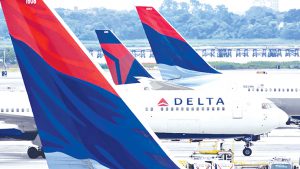BLOOMBERG
Delta Air Lines Inc sees profit this quarter topping Wall Street’s estimates, buoyed by steady bookings heading into the crucial summer travel season, even as it posted weaker-than-expected results for the first months of the year.
Adjusted second-quarter earnings will be $2 to $2.25 a share, the Atlanta-based airline said in a statement. That compares with a $1.61 analyst consensus estimate compiled by Bloomberg.
Revenue and average fares continue to grow, Chief Executive Officer Ed Bastian said, even if the pace of demand across the industry has moderated from a recent post-pandemic surge. The carrier forecast that second-quarter revenue will climb as much as 17% from the same period a year ago.
“If there are signs of slowing, don’t look here,†he said in an interview. Investors are watching for any signs of waning demand, particularly in April and May before summer leisure travel demand kicks in, as consumers face high prices and threats of recession. The air-travel industry, which so far has been resistant to those pressures, also has been battling stubbornly high operating costs.
Delta’s guidance for growth in average fares confirms demand strength in the peak summer travel period and “is a good sign for other international carriers,†Helane Becker, a TD Cowen analyst, said in a note. But investors remain concerned about non-fuel unit costs for the full year, which will need a “meaningful drop†in the second half to hit Delta’s forecast for a decline of 2% to 4% in 2023.
The company reiterated its existing expectation for full-year revenue growth of 15% to 20% over 2022 and earnings per share of $5 to $6. Delta’s pricing power for tickets is allowing the carrier to offset its own rising costs.
Delta’s first-quarter adjusted profit of 25 cents a share fell short of the 29-cent average from analyst estimates. Revenue excluding refinery sales was $11.8 billion, shy of analyst expectations for $12 billion.
Demand is typically weakest early in the year after peak holiday travel and before spring break. The 11 largest US airlines operating under their own brand are expected to report a combined net loss of $550 million for the quarter, with $50 billion in revenue and an operating profit of $400 million, according to Michael Linenberg, a Deutsche Bank analyst.
American Airlines Group Inc said that first-quarter profit will likely fall short of Wall Street’s estimates, with persistently high costs offsetting gains from steady travel demand. The airline will report full results on April 27.
Delta’s guidance counters investor concerns that followed American’s update, which was viewed by some “as signaling a meaningful slowdown in domestic demand in March,†Savanthi Syth, a Raymond James analyst, said in a note. Delta and United should have “outsized momentum†going into this quarter from growth in international demand, she said.
Delta’s non-fuel costs to fly each seat a mile, a gauge of efficiency, rose 4.7% — more than the carrier originally expected. The airline expects so-called unit costs to rise 1% to 3% in the second quarter. First-quarter revenue on the same basis climbed 23% year over year.
The airline will trim some flying this summer, primarily at New York’s LaGuardia Airport, in response to a Federal Aviation Administration request for help easing summer congestion, Bastian said without providing details.
 The Gulf Time Newspaper One of the finest business newspapers in the UAE brought to you by our professional writers and editors.
The Gulf Time Newspaper One of the finest business newspapers in the UAE brought to you by our professional writers and editors.
